Time management and organization is a struggle for many children with ADHD, as the deficit in working memory in particular can affect their understanding of how to sequence, organize, and prioritize. Setting up and maintaining routines can be quite difficult for them.
 So how can you help your ADHD child understand clocks and calendars and develop their time management skills?
So how can you help your ADHD child understand clocks and calendars and develop their time management skills?
Understanding and managing time is a huge part of being organised, and it’s important to work with your child, not only to master the concept of time, but also to learn to take control of time.
Help your child practice time management skills on a regular basis, and follow through with the systems you create together. Make sure your child is involved when setting up routines so that she will be motivated to find out what works best for her.
Here are some time management tips for ADHD Kids:
1. Sequence
Sequences include the concept of before and after: You need to do homework before dinner, you can have a story after your bath. In nursery and foundation classes, teachers often show children the daily schedule using words and pictures to create the sequence of the day. Reinforce these concepts at home by making sequences clear to your child by using verbal cues — first, next, then, before, after — as you develop your own routines. Concepts of before and after eventually develop into yesterday, today, and tomorrow, and develop further into past, present, and future. Ask your child to point out words that are related to time. Once your child has mastered the concept of sequence she will be better able to organize and prioritize tasks.
- Calendars
Use weekly calendars to introduce the concept of dates to your child. The weekly format works best for ADHD children as they tend to live in the present and they will more easily be able to learn the concepts of yesterday, tomorrow, and so on.
Fill in the dates on the calendar at the beginning of each week. At the top write the name of the month and its number (e.g. October = 10th month). Next to each day, write the numerical month and day (Monday, 24/10). This will help your child make associations quickly and not have to count 10 months from January on his fingers.
- Clocks and Timers
Practice telling time with your child at home. Ask her for a different way to say 6:45 (a quarter to seven, for example). Point out that the clock numbers 12 to 6 relate to after the hour, while 6 to 12 relate to before. Reinforce ideas like this over and over so your child can gain ownership of clock time. Set a timer to motivate targeted behaviors, such as transitions between activities. Tell your child he has five minutes to finish his work, and set an alarm to signal when time is up. If punctuality is a problem, include it as a goal on a daily reward/sticker chart or as part of a behavioral contract with your child’s teacher. Beware of dawdling – children with ADHD often use delaying tactics – like looking for equipment or sharpening pencils – to put off doing tasks they find boring.
- Planners
Just like adults, children need a place to keep track of deadlines, appointments, and other information. A planner will help your child manage all she has to remember — homework, birthday parties, sports events as well as her school timetable, friends’ phone numbers and addresses.
- Estimating Time and Prioritising Tasks
Encourage your child to start the most difficult piece of homework first, when they’re full of energy and enthusiasm. Having and using a planner regularly will help your child learn how to prioritize and manage assignments. Make a game out of predicting, timing, and checking your child’s estimates of the time needed for various activities. How long does it take to walk from the house to the bus stop? How long will a maths test take to finish? Children with ADHD find it difficult to estimate how much time has passed, so practicing in a fun way will help them to understand time much better.

